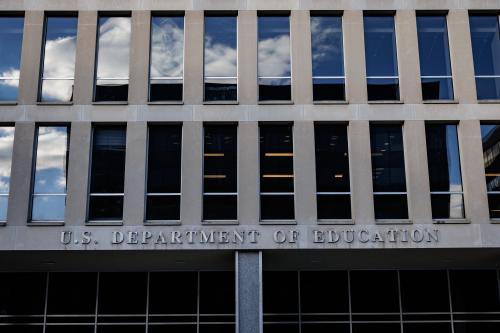The U.S. education system is undergoing profound change. Schools are recovering from pandemic disruptions, the teacher labor force is shrinking, and education technology is expanding—often outpacing research on its effectiveness. At the same time, the federal infrastructure that supports state and local education leaders has been weakened by the Trump administration’s actions over the past two months. While most education decision-making already occurs at the state and local levels, the administration’s proposed plans to further devolve authority over the use of Title I and IDEA funds would give states and districts even more discretion in deciding which policies to adopt and how to allocate federal resources.
The question now isn’t whether states and districts will face difficult decisions—but whether they’ll have the evidence they need to make them wisely. That’s where independent education research comes in.
What’s at stake now
The future of independent, policy-relevant education research is at risk. When the U.S. Department of Education (ED) recently laid off half of its workforce, the Institute of Education Sciences (IES), the research arm of ED, was hit hardest—losing 90% of its staff. Even before those cuts, nearly $1 billion in congressionally mandated funding had already been canceled. These cancellations abruptly halted evaluation studies on reading and math instruction, school-based mental health, college access, teacher preparation, and adult education. No other federal agency or private foundation has the infrastructure to take on education evaluation work at this scale.
Without a sustained federal commitment to rigorous, independent research and evaluation, schools and families will be left with fewer reliable sources of evidence to guide their decisions.
How independent research has informed real-world decisions
Over the past two decades, IES has supported a growing body of independent research and evaluation that has directly shaped decisions in schools, districts, and state legislatures. Below are just a few examples where IES-funded evaluations not only identified effective practices but also helped inform how policies were adopted, scaled, and sustained across the country:
- Mississippi’s evidence-based reading reform: Mississippi’s dramatic rise in 4th-grade reading scores is widely attributed to the state’s adoption of practices grounded in IES-supported research. After enacting the Literacy-Based Promotion Act, the state retrained K-3 teachers, deployed literacy coaches, and adopted science-based reading instruction. Mississippi’s NAEP scores rose from 49th to 21st in just under a decade. More than 30 states have since adopted similar “science of reading” laws.
- Early college high schools (ECHS): An evaluation by the American Institutes for Research (AIR) found that ECHS significantly increase college enrollment and degree attainment, especially for first-generation and low-income students. Following these findings, states like North Carolina and Texas expanded their ECHS networks. North Carolina now operates more than 100 early colleges, and Texas supports nearly 200 campuses, integrating the model into state policy and funding structures.
- CUNY’s Accelerated Study in Associate Programs (ASAP): The MDRC evaluation of CUNY’s ASAP, supported by IES, showed that comprehensive academic and financial supports doubled community college graduation rates. These findings led to citywide expansion in New York, with ASAP now serving over 25,000 students annually across all CUNY campuses. The model has since been replicated in multiple states. Ohio’s community colleges implemented “ASAP Ohio,” which also yielded large gains. Variations of the program have been adopted in Pennsylvania, Tennessee, North Carolina, California, West Virginia, Colorado, and Massachusetts.
- Boston pre-K program: IES-funded research on Boston Public Schools’ prekindergarten program found sizable gains in early literacy, language, math, executive function, and social emotional skills, particularly for underserved students. Based in part on these results, the city launched the Quality Pre-K Fund, expanded enrollment, and committed to universal access. IES-funded research on Boston pre-K programs informed the design and development of pre-K programs in other cities and states, including DC, Seattle, New York City, Maine, Mississippi, and Massachusetts.
- Reducing absenteeism in Philadelphia: A randomized evaluation supported by IES through the REL Mid-Atlantic found that a single mailed postcard reminding parents about the importance of attendance reduced absenteeism. A subsequent evaluation conducted by the AIR extended this work by testing an adaptive text-messaging strategy, finding that weekly reminders and same-day absence notifications reduced chronic absence—particularly for students with a history of high absences. The school district of Philadelphia scaled up this type of approach, and organizations like Attendance Works now promote similar low-cost strategies.
- Multi-tiered systems of support (MTSS): Building on IES-supported research and technical assistance, MTSS frameworks have been adopted by more than 30 states, including Florida, Michigan, Colorado, and Oregon. These models integrate academic, behavioral, and mental health supports. Tools like the Tiered Fidelity Inventory, developed through IES-funded centers, are now widely used by districts to guide implementation and monitor progress.
How this capacity was built
These kinds of impacts don’t happen by accident, nor do they happen overnight. Since its founding in 2002, IES has invested in the kinds of studies that can inform practice—large-scale evaluations that utilize randomized controlled trials, well-designed quasi-experiments, and high-quality implementation research. Many of these studies examine both costs and effects, aligning with the federal government’s commitment to efficiency and ensuring taxpayer dollars are used productively. Just as importantly, it has built a field of researchers trained to do this work well. Through predoctoral and postdoctoral fellowships, IES has supported more than 1,000 researchers, equipping them to design studies that address real-world policy needs, collaborate with schools and educators, and communicate findings clearly to decision-makers. Together, these investments have created a research ecosystem independent of commercial or political interests—one that is capable of producing actionable, trustworthy evidence when it’s needed most.
Looking ahead: Strengthening the role of independent research
We highlighted the above examples not simply because the programs worked—though that matters. The real win is that we have a federal agency like IES to fund this kind of research in the first place. Over two decades, IES built the infrastructure needed to test ideas at scale and trained researchers who understand both methods and the realities of implementing innovations in schools.
That capacity was deliberately built through sustained investment in people, partnerships, and infrastructure. As we look to the future, IES must continue supporting independent evaluations and ensure that the next generation of researchers is equipped to carry them out. Every day, schools make critical decisions about which programs to adopt, yet most interventions have never been rigorously tested. Federal investment in education research remains modest: IES’s FY24 budget was just $793 million, compared to $48 billion for NIH and $9 billion for NSF. Without IES, we lose not just studies, but the systems and expertise that make rigorous, actionable research possible.
The next chapter of IES should build on what has worked. That means continued investment in training and fellowships, cost-benefit evaluation studies, stronger infrastructure for rapid-turnaround studies, and better tools for translating research into timely, usable guidance. It also means preparing for what’s next—evaluating the wave of AI and digital tools transforming classrooms and using those same tools to accelerate how research is generated and shared.
The complex decisions facing schools and families aren’t going away—whether there’s a federal Department of Education or not. In fact, as states gain more latitude to adopt new policies and practices, the need for reliable, independent evidence will only grow. So, the question is: How do we want those decisions to be made? Based on vendor promises? Political talking points? Social media influencers? Or grounded in high-quality, independent research?
The answer is clear. Now is not the time to dismantle or defund the Institute of Education Sciences. It is the time to strengthen and improve it.
-
Acknowledgements and disclosures
These authors, like many others in the education research community, have conducted research that was funded by the Institute of Education Sciences. The views expressed here are solely those of the authors and do not represent the views of their institutions.
The Brookings Institution is committed to quality, independence, and impact.
We are supported by a diverse array of funders. In line with our values and policies, each Brookings publication represents the sole views of its author(s).









Commentary
How federal investments in education research help students succeed
April 10, 2025